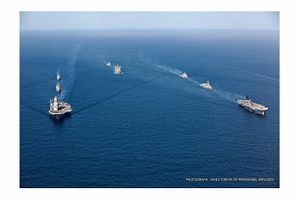In the past, Indian influence and culture spread to distant shores in Southeast Asia, East Asia, and East Africa, among other parts of the world through the maritime realm. However, once the country became independent in 1947, the focus turned inward and India became more of a continental power. This was dictated by geography, as New Delhi became embroiled in land wars with its western neighbor Pakistan and a short border war with its northern neighbor China.
This continental focus seems to be changing in recent times, especially since the end of the Cold War and the liberalization of the Indian economy. In keeping with New Delhi’s increasing attention toward the maritime domain, the Indian Navy recently held an International Fleet Review off Visakhapatnam, on India’s eastern seaboard, earlier this month. With a smorgasbord of naval vessels from over 50 countries across the world in attendance, the event was undoubtedly significant.
This marks the second time that India has hosted an International Fleet Review. The first took place in 2001 off Mumbai and saw naval vessels from 29 countries in attendance. Generally, Fleet Reviews are held once during the term of each Indian president.
The Indian Navy plays a key role in ensuring the safety and security of India’s sea lanes of communication. This is important since India is a net importer of energy. The Navy has also played a key role in the evacuation of Indian nationals from war zones, including in Yemen recently. As Prime Minister Narendra Modi noted in his speech at the International Fleet Review, the Indian Ocean is one of the most important waterways of the world and through it traverses “half of the world’s container traffic and close to one-third of the world’s cargo traffic.”
Given this context, why is this recent International Fleet Review so important?
First, the latest review demonstrates that the Modi government has its sights set on increasing India’s maritime footprint. During his visit to the Indian Ocean island countries of Seychelles, Sri Lanka, and Mauritius in March last year, Modi outlined that India seeks “a future for the Indian Ocean that lives up to the name of SAGAR — Security and Growth for All in the Region.”
Second, the review underlines India’s firm commitment to maintaining the Indian Ocean as its “strategic backyard.” Beijing’s efforts to increase its influence in the Indian Ocean region through initiatives like the “Maritime Silk Road” and its outreach to countries in India’s immediate neighborhood like Sri Lanka and the Maldives have only strengthened New Delhi’s resolve.
Third, the review highlighted that the Indian Navy is keen to increase its interoperability with the navies of many countries. The aspiration to greater interoperability is broad, covering areas like anti-piracy efforts and disaster relief. India joined hands with countries like the United States, Australia, Japan, and Indonesia to provide rescue and recovery efforts in the wake of the Boxing Day tsunami of 2004. It has also been a proactive player in anti-piracy efforts in the Indian Ocean region. Moreover, New Delhi now buys naval hardware from a host of countries, a change from earlier times. For instance, India bought P-8I maritime patrol aircraft from the United States and is negotiating to buy Japanese-made US-2 maritime reconnaissance aircraft. A broader range of defense hardware can abet Indian aspirations to increased interoperability with partner navies.
However, despite the focus on positive trends at the fleet review, India continues to face significant challenges in the naval domain. Its submarine fleet has suffered a string of mishaps in the last couple of years. Additionally, the Indian Navy’s share of the defense budget stood at a dismal 16 percent of the total last year, highlighting its relative backseat to the country’s land and air forces. For instance, the Indian Army got 53 percent of the defense budget.
New Delhi has also borne the brunt of terrorist attacks through the sea as seen in the horrendous Mumbai 2008 attacks. Coastal security still remains a concern today, especially given that India has a huge coastline of around 7,500 km. New Delhi also has to step up its indigenization processes. It is already building its first aircraft carrier, the INS Vikrant, which is expected to be commissioned in 2017.
In his book, The Influence of Sea Power Upon History 1660-1783, the renowned naval historian and strategist Alfred Thayer Mahan noted that it was the British Navy that stood between Napoleon and his domination of the world. As New Delhi aspires to play a bigger role on the global stage, the Navy will remain an important force multiplier.
All said and done, the Indian Navy will play an increasingly proactive role in the coming years and months in the waters of the Indo-Pacific. As in the past, command of the high seas will be one of the key determinants of geopolitical influence.
Dr. Rupakjyoti Borah is a Research Fellow with the Japan Forum for Strategic Studies, Tokyo. He researched Japan-India maritime relations as a Visiting Fellow at the Japan Institute of International Affairs, Tokyo. The views expressed are personal. Twitter @rupakj.
































